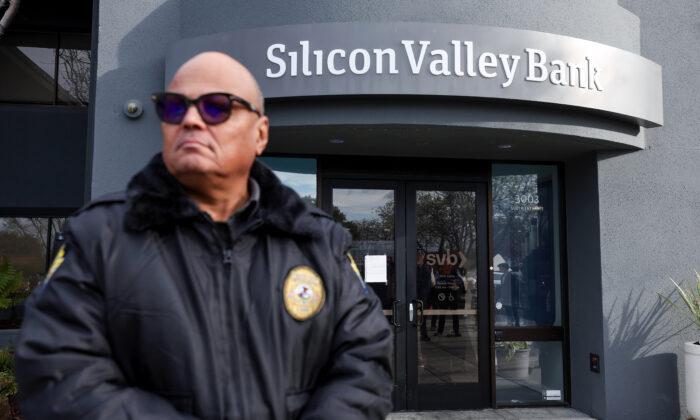American banks are currently raising their savings rates to keep customers from running due to jitters following the collapse of Silicon Valley Bank (SVB) and Signature Bank.
The failure of SVB occurred when confidence in the bank’s financial health led uninsured customers whose deposits were larger than Federal Deposit Insurance Corp.’s $250,000 limit to shift their money to bigger banks with more stable assets, leading to a bank run.
The mass exodus from SVB also made it unable to make any loans to its start-up customer base.Signature Bank of New York collapsed for a similar reason and threatened First Republic Bank as well.
A massive loss of confidence in the industry led many depositors across the country to reshuffle their deposits, forcing federal regulators to contain the crisis and halt future bank runs, with aid to ensure that uninsured depositors could access their money.
Regional Bank Crisis Spurs Lenders to Act
The collapse of SVB and Signature have hammered Wall Street and lending, and U.S. economic growth is expected to decline this year while the chance of a major recession is increasing.Regional and smaller banks lost a record $119 billion in deposits since the beginning of March, while the 25 largest banks gained $67 billion in deposits, according to a JPMorgan analysis of data from the Federal Reserve last week.
“It’s likely that concerns about maintaining deposit levels have put upward pressure on some deposit rates at some banks,” Ken Tumin, founder of DepositAccounts.com, told USA Today, which tracks bank savings and CD rates.Tumin said that the pace of the rate increases skyrocketed after the SVB crisis hit the news on March 8, as the average online savings rate rose by 22 basis points, to 3.74 percent between March 1 and March 24.
The increases have occurred despite the Fed’s decision to slow down its rate hikes, from 50 basis points in December to 25 basis points in each February and March.
That suggests that the SVB and Signature Bank failures are likely partially responsible for the recent pickup in bank rate increases, said Tumin. He said that banks now want to “shore up their deposits to reduce the odds of being hurt by a bank run.”
A few online banks have increased their deposit rates because it is easier for customers to move money to competitors, he said.Tumin wrote that Ally Bank’s move to raise the rate of its 11-month, no-penalty CD from 4.0 percent to 4.75 percent on March 11—the day after the collapse of SVB—may have been designed to “reduce outflows of deposits from skittish customers.”
Ally Bank’s higher rate added $138 in interest during the 11-month term on a $20,000 deposit.
However, a few banks may trying to take advantage of the crisis by snatching some of the deposits ricocheting through the banking system rather than trying to stem the loss of funds, Garry Zimmerman, founder of MaxMyInterest.com, told USA Today.“I think banks are being opportunistic and seeing this ... as a good opportunity to capture a customer relationship,” said Zimmerman.
Customers Benefit From Higher Savings Rates
The Federal Reserve’s decision to raise interest rates on March 22, for the ninth consecutive month, was good news for savers seeking higher yields on their accounts. And some customers indeed are benefiting from the crisis, as they receive a boost to their bank savings rates.“Returns on savings accounts and CDs are the best in 15 years,” said Greg McBride, chief financial analyst for Bankrate.com.
Higher savings rates will allow depositors at smaller banks to earn some money after years of earning low interest in their savings accounts, while the larger banks still offer low savings rates.
Meanwhile, McBride does not exactly believe there is a direct connection between the bank crisis and higher savings, or CD rates.
“In a rising rate environment, banks that have been consistently paying competitive yields have repeatedly increased their payouts to remain competitive,” he added.
The after-effects of the March bank crisis on savings rates can be hard to assess, as bank interest rates were already climbing significantly since the Fed started to hike its borrowing rate by 4.75 percentage points last year in an effort to combat high inflation.
Most banks with physical branches have raised their savings rates to 0.35 percent because they tend to have plenty of deposits, but online banks, which tend to be smaller, are more aggressive.
Online bank savings accounts are now offering rates as high as 5 percent, well above the 0.23 percent national savings account average, according to Bankrate.
“You’re leaving a lot of money on the table if you don’t go to an online bank,” said McBride.
DepositAccounts.com, in a separate report, said the average online savings rate is now at 3.52 percent, up from 0.49 percent a year ago.It also reported that the average online one-year CD rate is 4.56 percent, up from 0.67 percent a year ago.
Some federally insured one-year CDs now have rates as high as 5.15 percent, well above the current 1.62 percent national average, reported USA Today.






Friends Read Free